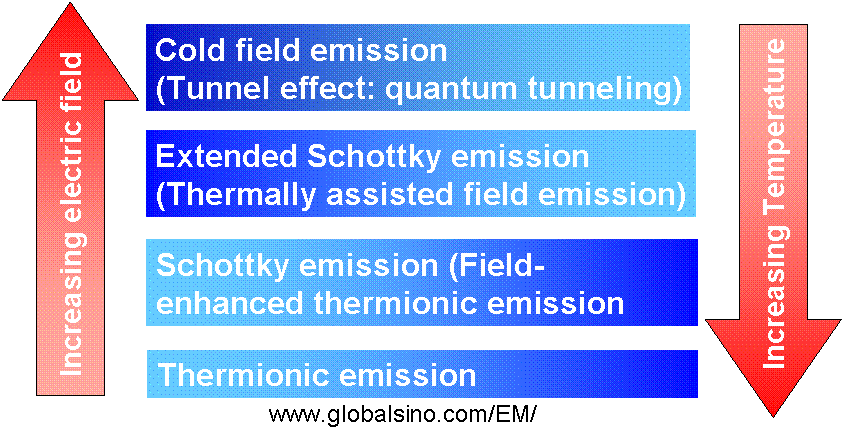=================================================================================
Before the application of field emission electron guns (FEG) in TEM, the energy resolution of EELS systems had been ~1–2 eV, mainly limited by the energy spreading of thermionic electron source (tungsten filament or LaB6). In the late 1990s, Schottky emission sources became available and have been providing energy resolution greater than 0.5 eV. A Schottky emission electron gun is based on field-assisted thermionic emission [3] and the electrons overcome the barrier lowered due to the Schottky effect without tunnelling.
Figure 4317 shows the differences of operating electrical field and temperature to emit electrons in various electron guns.

Figure 4317. The differences of operating electrical field and temperature to emit electrons in various electron guns.
Schottky field-emitters [1] do not have such high coherence as CFE guns but on the other hand do not require extreme UHV conditions and the beam current does not decay during operation. Furthermore, a table on the comparison of various electron sources is presented in page1409.
Compared to the cold field emitter, the Schottky electron source has a much larger emission area. The energy resolution of EELS with a Schottky electron gun is limited to 0.5–1.0 eV due to thermal broadening. The energy resolution is increased by over a factor of two (e.g. ∼0.2–0.4 eV) with cold field emission or even monochromatic electron sources.
The energy resolution in thermally assisted field-emission gun (FEG) can be higher in cold-cathode mode (with thermal assistance turned off) than in the normal operation condition. For instance, the energy resolution of 0.7 eV was obtained in cold-cathode mode while it was 0.9 eV in normal condition with Gatan 666 PEELS spectrometer in Philips 400ST-FEG TEM [2].
[1] Bakker, H., Bleeker, A., Mul, P., 1996. Design and performance of an ultrahigh
resolution 300 kV microscope. Ultramicroscopy 64, 17–34.
[2] Laurence A. J. Garvie, Peter R. Buseck, and Peter Rez, Characterization of Beryllium–Boron-Bearing Materials by Parallel Electron Energy-Loss Spectroscopy (PEELS), Journal of Solid State Chemistry 133, 347 - 355 (1997).
[3] Reimer L (1997) Transmission Electron Microscopy, 4th edn, p. 90.
(Springer-Verlag, Berlin.)
|
